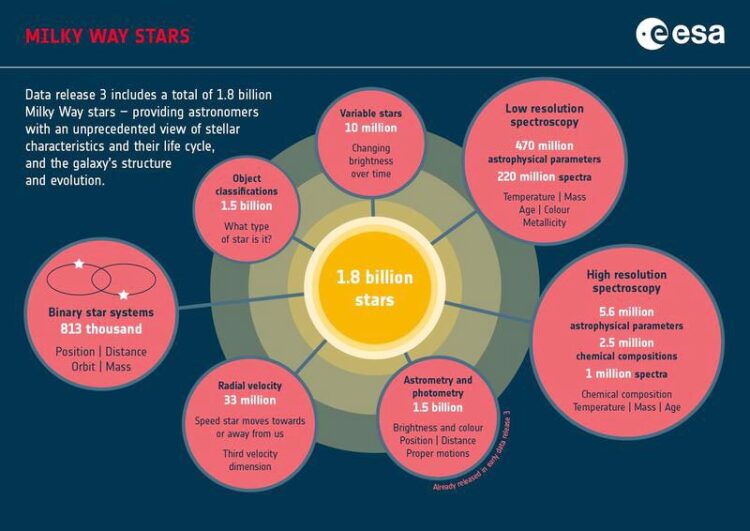The first galactic census comes to a close

Data release 3 from ESA’s Gaia mission includes a total of 1.8 billion (thousand million) Milky Way stars – providing astronomers with an unprecedented view of stellar characteristics and their life cycle, and the galaxy's structure and evolution.
Credit: ESA
While the national census is only just beginning in Germany, the first evaluation of our galactic neighborhood as part of the ongoing census has now been completed with the assistance of researchers at TU Dresden. The data acquired for this survey as part of the European Space Agency’s Gaia mission will be released to the public during a celebratory event on June 13, 2022, at 12:00°pm CEST.
Since 2014, the Gaia satellite has been surveying the galaxies at a distance of 1.5 million kilometers from Earth and recording the positions of all celestial objects visible to it with extreme precision. And because Gaia observes each object multiple times, the celestial objects’ velocities and positions can also be derived from these measurements. An international team of researchers, including those at TU Dresden’s Lohrmann Observatory, is rocessing the data to create the most accurate and complete map of our Milky Way. While the positions and velocities of about 1.8 billion celestial objects were published in December 2020, the new dataset expands this information considerably.
Just like a national census, Gaia also records a breadth of additional information, which makes up the content of the current catalogue (Data Release 3). Here are just a few highlights from this extraordinary treasure trove of data: In addition to the largest collection of astrophysical data ever recorded on stars in the Milky Way, the catalogue contains the most spectra and radial velocities of stars ever measured. Not only does the data included on binary stars surpass all work done in this field in the last 200 years, but the abundance of newly published data on brightness, shape and redshift of galaxies neighboring our own is unprecedented in scope for the worldwide astronomical community.
The Dresden team led by TUD professor Sergei Klioner was instrumental in creating the quasar catalogue with nearly 2 million entries in total. These quasars, the luminous nuclei of distant galaxies, form the basis of the new celestial reference system, which was officially adopted by the International Astronomical Union in August 2021 and will now be used by all astronomers to describe the positions of celestial bodies. As part of the national event, Prof. Klioner will provide a report in Heidelberg on this work and the contribution of Dresden’s scientists to other parts of the catalogue. The event will be streamed live online on June 13, 2022, starting at 11:00°am. Information on the event as well as a Zoom link to the meeting can be found on the website for Heidelberg University’s Center for Astronomy.
The team at Lohrmann Observatory are also holding a lecture at TU Dresden on Friday, July 1, 2022, at 5°pm as part of this data release. All members of the public are welcome to attend. The team will share details on the challenges of processing data, the fascinating science of Gaia and future plans. The lecture will be held in Room E03 in the Faculty of Computer Science building (Andreas Pfitzmann Bau Building, Nöthnitzer Str. 46, 01187 Dresden).
Wissenschaftliche Ansprechpartner:
Prof. Dr. habil. Sergei A. Klioner
TU Dresden
Institute of Planetary Geodesy
Astronomy Group / Lohrmann Observatory
Tel. +49 351 463-32821
Email Sergei.Klioner@tu-dresden.de
https://astro.geo.tu-dresden.de
Weitere Informationen:
https://zah.uni-heidelberg.de/talks-seminars-events/gaia-data-release-3-june-13 Webpage on the national event at the Center for Astronomy in Heidelberg
https://www.esa.int/ESA_Multimedia/ESA_Web_TV ESA Web TV
Media Contact
All latest news from the category: Physics and Astronomy
This area deals with the fundamental laws and building blocks of nature and how they interact, the properties and the behavior of matter, and research into space and time and their structures.
innovations-report provides in-depth reports and articles on subjects such as astrophysics, laser technologies, nuclear, quantum, particle and solid-state physics, nanotechnologies, planetary research and findings (Mars, Venus) and developments related to the Hubble Telescope.
Newest articles

Superradiant atoms could push the boundaries of how precisely time can be measured
Superradiant atoms can help us measure time more precisely than ever. In a new study, researchers from the University of Copenhagen present a new method for measuring the time interval,…

Ion thermoelectric conversion devices for near room temperature
The electrode sheet of the thermoelectric device consists of ionic hydrogel, which is sandwiched between the electrodes to form, and the Prussian blue on the electrode undergoes a redox reaction…

Zap Energy achieves 37-million-degree temperatures in a compact device
New publication reports record electron temperatures for a small-scale, sheared-flow-stabilized Z-pinch fusion device. In the nine decades since humans first produced fusion reactions, only a few fusion technologies have demonstrated…





















